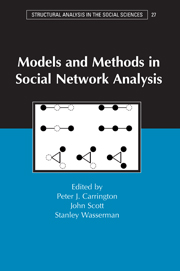Book contents
- Frontmatter
- Contents
- Acknowledgments
- Contributors
- 1 Introduction
- 2 Recent Developments in Network Measurement
- 3 Network Sampling and Model Fitting
- 4 Extending Centrality
- 5 Positional Analyses of Sociometric Data
- 6 Network Models and Methods for Studying the Diffusion of Innovations
- 7 Using Correspondence Analysis for Joint Displays of Affiliation Networks
- 8 An Introduction to Random Graphs, Dependence Graphs, and p*
- 9 Random Graph Models for Social Networks: Multiple Relations or Multiple Raters
- 10 Interdependencies and Social Processes: Dependence Graphs and Generalized Dependence Structures
- 11 Models for Longitudinal Network Data
- 12 Graphic Techniques for Exploring Social Network Data
- 13 Software for Social Network Analysis
- Index
- Structural Analysis in the Social Sciences
11 - Models for Longitudinal Network Data
Published online by Cambridge University Press: 05 June 2012
- Frontmatter
- Contents
- Acknowledgments
- Contributors
- 1 Introduction
- 2 Recent Developments in Network Measurement
- 3 Network Sampling and Model Fitting
- 4 Extending Centrality
- 5 Positional Analyses of Sociometric Data
- 6 Network Models and Methods for Studying the Diffusion of Innovations
- 7 Using Correspondence Analysis for Joint Displays of Affiliation Networks
- 8 An Introduction to Random Graphs, Dependence Graphs, and p*
- 9 Random Graph Models for Social Networks: Multiple Relations or Multiple Raters
- 10 Interdependencies and Social Processes: Dependence Graphs and Generalized Dependence Structures
- 11 Models for Longitudinal Network Data
- 12 Graphic Techniques for Exploring Social Network Data
- 13 Software for Social Network Analysis
- Index
- Structural Analysis in the Social Sciences
Summary
This chapter treats statistical methods for network evolution. It is argued that it is most fruitful to consider models where network evolution is represented as the result of many (usually nonobserved) small changes occurring between the consecutively observed networks. Accordingly, the focus is on models where a continuous-time network evolution is assumed, although the observations are made at discrete time points (two or more).
Three models are considered in detail, all based on the assumption that the observed networks are outcomes of a Markov process evolving in continuous time. The independent arcs model is a trivial baseline model. The reciprocity model expresses effects of reciprocity, but lacks other structural effects. The actor-oriented model is based on a model of actors changing their outgoing ties as a consequence of myopic stochastic optimization of an objective function. This framework offers the flexibility to represent a variety of network effects. An estimation algorithm is treated, based on a Markov chain Monte Carlo (MCMC) implementation of the method of moments.
Some Basic Ideas About Longitudinal Social Network Data
The statistical modeling of social networks is difficult because of the complicated dependence structures of the processes underlying their genesis and development. One might think that the statistical modeling of longitudinal data on social networks is more difficult than modeling single observations of social networks.
- Type
- Chapter
- Information
- Models and Methods in Social Network Analysis , pp. 215 - 247Publisher: Cambridge University PressPrint publication year: 2005
- 282
- Cited by



